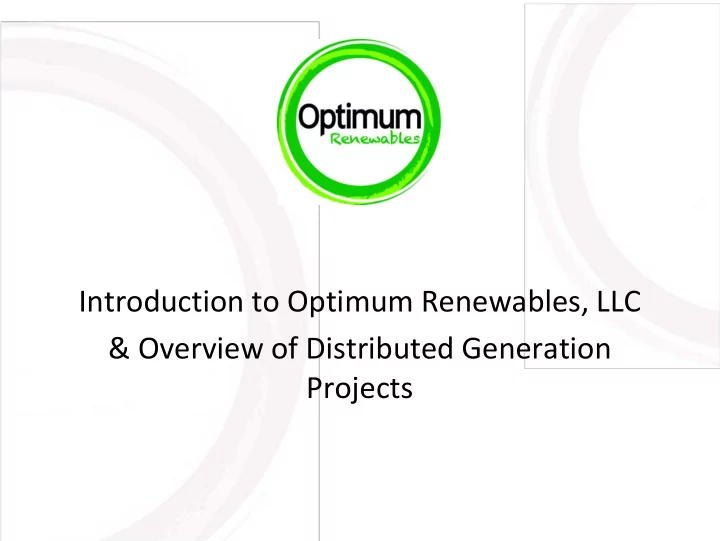

Introduction to Optimum Renewables, LLC & Overview of Distributed Generation Projects
Presentation Outline Optimum Renewables Mission & Management Team Overview of Distributed Generation (DG) Projects Complexities of DG projects Outlook for DG projects Open Discussion
Mission Optimum Renewables, along with industry partners, is focused on developing renewable energy projects in North America. Optimum Renewables works with investors, land owners, developers, manufacturers, service providers, utilities and transmission companies to integrate solar and wind projects into the North American electrical grid.
Management Team The two members of Optimum Renewables senior leadership share a passion for business, customer service, and engineering that is unmatched in the power industry. Steve Thompson, CEO. Steve is an Electrical Engineer by education and an experienced executive leader though a long record of business success. Esther Reinders, CFO. Esther has a degree in Chemical Engineering and Masters in Business, with strong financial management and customer relations success.
My Background . 17 years in the Oil & Gas Industry. V.P System Engineering for Compressor Controls Corp.. 5 years Wind Turbines Operations and Maintenance CEO of Availon, inc.
Present Project Locations
Present Project Photos
Presentation Outline Optimum Renewables Mission & Management Team Overview of Distributed Generation (DG)Projects Complexities of DG projects Outlook for DG projects Open Discussion
Overview of Distributed Generation (DG)Projects Distributed generation (DG) refers to power generation at the point of consumption. Generating power on-site or close to load centers, rather than centrally, eliminates the cost, complexity, interdependencies, and inefficiencies associated with transmission and distribution . Microgrids are modern, localized, small-scale grids, contrary to the traditional, centralized electricity grid (macrogrid). Microgrids can disconnect from centralized grid and operate autonomously, stregthen grid resilience and help mitigate grid disturbances.
Overview of Distributed Generation (DG)Projects Smaller projects normally 2MW-8MW, rarely more than 20MW Interconnection is made at distribution Voltage Levels normally 12KV to 24KV Interconnection is done at a “Point of Interconnection” (POI) and does not require a substation. DG owner is responsible for the POI. Utility is responsible for upgrades to the POI. Most are built around PURPA (Public Utilities Regulatory Policy Act of 1978) regulations
Overview of Distributed Generation (DG)Projects
Presentation Outline Optimum Renewables Mission & Management Team Overview of Distributed Generation (DG) Projects Complexities of DG projects Outlook for DG projects Open Discussion
Complexities of (DG)Projects Smaller projects lead to increased project costs per MW Interconnection costs are high: $400k to $1,500k Finding the right land for the turbines close to a substation with adequate load Project IRR’s often to low to attract investors Projects to small to attract tax equity investors
Presentation Outline Optimum Renewables Mission & Management Team Overview of Distributed Generation (DG) Projects Complexities of DG projects Outlook for DG projects Open Discussion
Outlook for (DG)Projects States will need to encourage these type projects with incentives to make them financially viable. Most Utilities are looking for ways to discourage this type of project: Delays in the interconnection process, high interconnection costs, lowering their avoided cost rates Low fuel prices and the diminishing Federal Production Tax Credit (PTC) will make DG projects more difficult
Outlook for (DG)Projects
Presentation Outline Optimum Renewables Mission & Management Team Overview of Distributed Generation (DG) Projects Complexities of DG projects Outlook for DG projects Open Discussion
Recommend
More recommend